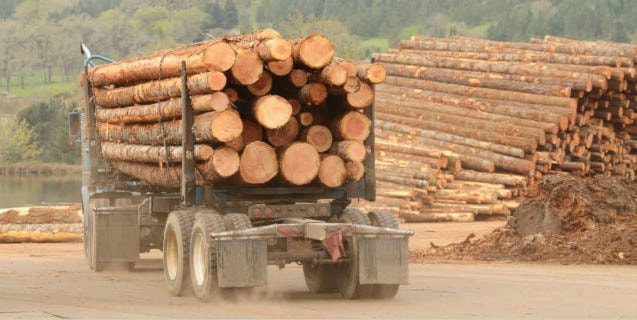The forest industry in Houston, already challenged in the past year with curtailments of Canfor’s large sawmill, will remain front and centre with next year’s planned reduction of the annual allowable cut (AAC) for the Morice Timber Supply Area (TSA).
Currently at 1.9 million cubic metres a year, set in 2015, the AAC is set to drop to 1.6 million cubic metres as of mid-March 2020, a 16 per cent reduction.
It’s one of the subjects Nechako Lakes BC Liberal MLA John Rustad will have on the agenda at a public meeting he wants to have here.
“We’ve been having these meetings in a number of places,” said Rustad in reeling off a list of communities where BC Liberal MLAs have had meetings concerning mill closures, a declining log supply and the high cost of logging.
“Quesnel, 100 Mile House, Williams Lake, Mackenzie,Valemount, Fort St. John, Fort St. James and Prince George,” he said in listing just a few of the meeting places.
For the most part, the planned Morice TSA reduction reflects the drop in the commercial value of pine beetle stands killed by the mountain pine beetle, indicates the AAC rationale for the Morice TSA released in 2015.
“After the shelf life — the period of time after death that timber remains commercially usable — of the dead pine expires, at the end of year five, there is not enough live pine and non-pine volume available to maintain the initial harvest level,” then-chief forester Dave Peterson wrote.
Rustad said Houston has already gone through the economic impact of a mill closure which took place in 2014 when West Fraser closed Houston Forest Products as part of a deal with Canfor. That deal saw Canfor closed its Quesnel with the companies then swapping timber licences in the two companies so that Canfor had more wood here and West Fraser more wood in Quesnel.
“So Houston has already faced that, a mill closure,” said Rustad. “But this time, with the [AAC] reduction, where you are going to see the impact is in logging, with the contractors. That’s who is going to be affected.”
Rustad did say that as Coastal GasLink natural gas pipeline construction activity ramps up there will be job opportunities, at least for the short term.
And unhappy with how the provincial NDP government is responding to mill closures and curtailments, the BC Liberal opposition has outlined a five-point action plan it wants implemented.
“Adequate social services, including mental health services, need to be prioritized in these communities to address the cumulative impacts on workers and their communities,” reads one portion of the BC Liberal document.
“The provincial government must ask the federal government to establish programs such as retirement bridging for eligible workers and work-sharing,” it adds.
“Forest fire fuel mitigation can employ workers immediately. The provincial government must make money available to local governments specifically for displaced forestry workers to remove fuel to reduce the risk of wildfires in communities,” the document continues.
Easing closure impacts, however, is just the first task the province needs to accomplish, said Rustad.
He’s calling for a complete overhaul of how the province manages timber with a view to eventually expanding what can be cut and from that, what can then be manufactured.
“We have 23 million hectares in our timber harvesting land base,” said Rustad. “Sweden, which has similar terrain to us, has 21 million hectares. But their cut is 50 per cent above ours — 92 million cubic metres.”
“What we need to do look at what Sweden does. And this is not a short term thing, it could be 30 years but that’s what’s needed. A complete shift, beginning with legislation,” he said.
And once the legislation is in place, industry will then have the confidence there’s a foundation through which they can make the necessary investments in their mills and equipment, Rustad continued.
“Then they can have a clear path. They can say ‘I have the confidence now, I can understand’,” he added.
The Houston area isn’t alone in facing annual cut reductions — there are similar concerns in the Burns Lake area as well where the timber supply for that area is under review.
And companies across B.C. are reporting challenges of decreased log supplies as well as high logging costs.
Canfor’s downtime here was repeated elsewhere at its other B.C. operations and, earlier this year, announced it was closing its Vavenby mill north of Kamloops for good and selling its forest licence in that area to Interfor.
Not specific to Houston, the company has acknowledged the log supply situation across the province.
“As outlined by the BC government, the AAC is going to continue to decline across the BC Interior over the next several years. This is largely a result of the end of mountain pine beetle epidemic, which resulted in higher harvesting levels,” said Canfor’s Michelle Ward.
“Across all of our operations we’re focused on ensuring we have a secure timber supply over the long term.”
Based on current information supplied by the forests ministry, Canfor now has approximately 1.265 million cubic metres under licence, West Fraser has 265,000 cubic metres (destined for its Smithers mill) and BC Timber Sales, a provincial crown agency, has 264,000 cubic metres.
The Lake Babine Nation holds a non-replaceable forest licence within the Morice TSA and is a partner in the Babine Community Forest.
The Dungate Community Forest, owned by the District of Houston, has a licence to cut 29,000 cubic metres a year, mostly selling to Canfor.
It’s developing a plan to apply for a 10 per cent increase but, indicates the forests ministry in information provided, because of next year’s AAC reduction, “there is no AAC available in the TSA for [community forest] expansion.”
Rustad said he’s planning his forestry issues meeting in conjunction with the District of Houston and the Houston and District Chamber of Commerce.
